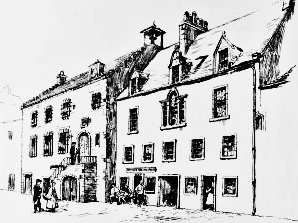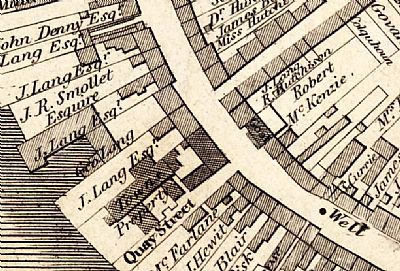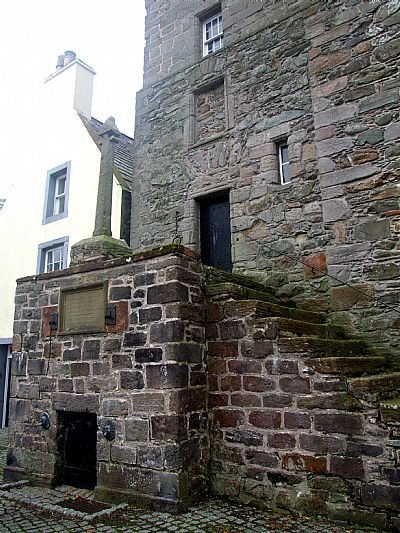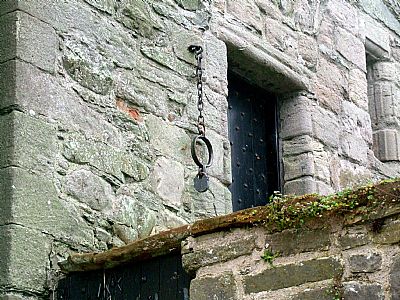TOLBOOTH
Mid-way along Dumbarton High Street. Also see HIGH STREET : index.asp?pageid=736726
Dumbarton Sheriff Court : DUMBARTON SHERIFF COURT HOUSE, DUMBARTON
Dumbarton Liobrary : DUMBARTON LIBRARY, STRATHLEVEN PLACE, DUMBARTON
Although long since faded into history, one can locate where it stood by standing with one's back to Quay Street. Opposite you and across the High Street stretches the Artizan Centre. That mall replicates the Cross Vennel which led up into College Way, but not quite at the same place. Cross Vennel was a few buildings west of the current mall. Anyway this allows you to visualise how the Tolbooth looked across the High Street and down to the Leven which at that time had many trading vessels.
A tolbooth or town house was the main municipal building of a Scottish burgh, from medieval times until the 19th century. The tolbooth usually provided a council meeting chamber, a court house and a jail. The tolbooth was one of three essential features in a Scottish burgh, along with the mercat cross and the kirk. [Wiki]. That in Dumbarton served as a council chamber, administrative centre and also a courthouse. With this latter role came that of prison. For what then replaced that, see Dumbarton Prison. index.asp?pageid=716578 For the Burgh Halls, Also known as the Academy Buildings see index.asp?pageid=715707The word tolbooth is derived from the Middle English word tolbothe that described a town hall containing customs offices and prison cells [Wiki].
Most of the business carried out here would have been mundane, convictions usually minor. But the passing of the Scottish Witchcraft Act in 1563 made witchcraft, or consulting with witches, capital crimes in Scotland and some such convictions would have been made here.
It is estimated that between 3,000 and 5,000 women were publicly accused of being witches in 16th and 17th Century Scotland, a much higher number than in England. In the 17th century, people believed that the unholy forces of witchcraft were lurking in their communities, and those accused of being witches were persecuted on the basis of these dark suspicions. Dumbarton had its share - 16 being recorded within Dumbarton and some elsewhere within the county. Those convicted were usually executed.
This is long gone. In fact the Tolbooth building was reported as being ruinous in 1635, although some funds were allocated for its rebuilding in 1639. It was replaced by Heggie's Buildings in 1830-2.

This picture shows the Tolbooth on the left with a large house to the right with commercial premises below. This si Mackenzie House. (A small piece of that house, the "gable" of trhe upper central window, exists built into the side door of Dumbarton LIbrary). The entrance to the left with a sign above is a pub. There is a large house beyond the Tolbooth as well and just beyond it would have been the Cross Vennel.

This 18th map by John Woods we can see "GAOL" just opposite Quay Street. Cross Vennel is a little to the north west (not where the Artizan Centre mall is now). Glencairn Greit House though is opposite Cross Vennel; river access from its back door.

This is the Kirkcudbrigth Tolbooth which still survives intact and is similar in many ways to that of Dumbarton, certainly in the way there are steps up from the street to the first floor.

There is even an iron shackle to remind us of the building's role as courthouse and prison. Some of those convicted could find themselves on display up here and subject to the wrath of the passing public.
GEOGRAPH - Lairich Rig. https://www.geograph.org.uk/article/Dumbarton-Prison
CANMORE : https://canmore.org.uk/site/42349/dumbarton-high-street-old-tolbooth
WIKIPEDIA : https://en.wikipedia.org/wiki/Tolbooth

